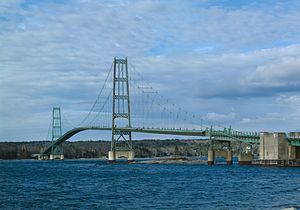Deer Isle Bridge
Coordinates: 44 ° 17 ′ 36 ″ N , 68 ° 41 ′ 21 ″ W.
| Deer Isle Bridge | ||
|---|---|---|
| Official name | Deer Isle – Sedgwick Bridge | |
| use | Road bridge | |
| Crossing of | Eggemoggin Reach | |
| place | Maine , USA | |
| construction | Suspension bridge | |
| Longest span | 329 m | |
| Clear height | 26 m | |
| opening | June 1939 | |
| planner | David B. Steinman | |
| location | ||
|
|
||
Deer Isle Bridge (officially: Deer Isle – Sedgwick Bridge ) is a road bridge that spans State Road SR 15 from Sedgwick , Hancock County , Maine over the Eggemoggin Reach called Little Deer Isle to Little Deer Isle in Town Deer Isle and across a causeway immediately adjacent to Deer Isle . The bridge is the only connection between the islands and the mainland.
description
The suspension bridge makes an extremely light impression. Two comparatively thin suspension cables run over the two slender pylons , carrying a very flat bridge deck that rises towards the center and on which there is space for the two narrow lanes of the road.
The suspension bridge, including the ramp bridges, is 763 m long and has a span of 329 m and a clearance height of 26 m above MHWS (medium spring flood). The two-lane road on the bridge is 6.60 m wide. The 64 m high steel pylons carry two suspension cables, each consisting of 19 parallel, laid wire ropes . Not only the vertical hangers that support the bridge deck are attached to the suspension cables, but also several stay cables both lengthways and some diagonally across the girder. There are also six cross connections between the suspension cables. The roadway girder is a plate girder construction that is only 2 m high. In 1993 wind-deflecting sheets were installed along the outer edges.
history
Construction of the Deer Isle Bridge was supposed to begin in the early 1930s, but repeatedly failed due to insufficient or insufficient budgets. The engineering firm Robinson & Steinman , which was commissioned with the planning, had to change its plans several times in order to adapt them to the low financial framework. So was z. B. selected a roadway that rises at 6.5%, on the one hand to achieve the required clearance height, but on the other hand to keep the ramp bridges as short as possible. The light road deck enabled light pylons and thinner suspension cables. Shortly after construction began, David B. Steinman experienced wind-induced vibrations on his recently completed Thousand Islands Bridge . When the Deer Isle Bridge also showed similar vibrations with the roadway not yet completely finished, he installed the same system of stay cables and stiffeners on it. Both bridges were decisive for Steinman's realization that the widely recognized deflection theory in its form at the time did not take into account the aerodynamic effects of the wind. That is why he provided the Mackinac Bridge, which was built from 1954 to 1957 and is regarded as his life's work, with extremely deep and stiff girders made of wind-permeable half-timbered structures.
Web links
Individual evidence
- ↑ Deer Isle Bridge on Historic Bridges.org, with numerous photos
- ^ A b Richard Scott: In the wake of Tacoma, suspension bridges and the quest for aerodynamic stability . ASCE Press, Reston, Va. 2001, ISBN 0-7844-0542-5 , p. 35 ff

